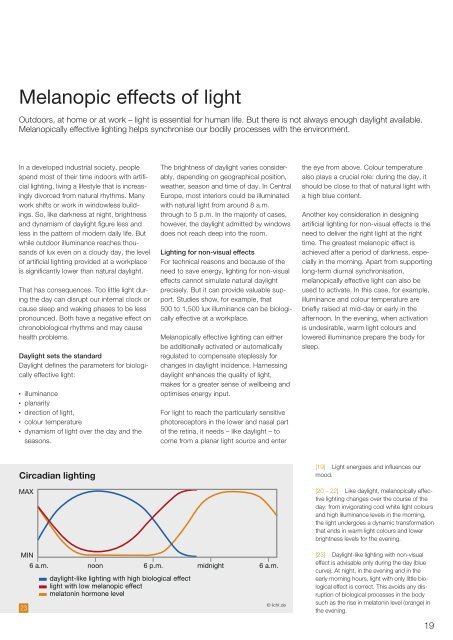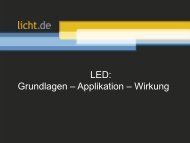licht.wissen 19 No. "Impact of Light on Human Beings"
Light synchronises our “internal clock”. Lighting that copies daylight has more than just a visual impact; it supports bodily functions 24 hours a day. Booklet 19 is intended for all those who want to delve into the topic of Impact of Light on Human Beings. The 56 pages helps to get an overview of what melanopic light can effect. Free Download at www.licht.de/en
Light synchronises our “internal clock”. Lighting that copies daylight has more than just a visual impact; it supports bodily functions 24 hours a day. Booklet 19 is intended for all those who want to delve into the topic of Impact of Light on Human Beings. The 56 pages helps to get an overview of what melanopic light can effect. Free Download at www.licht.de/en
You also want an ePaper? Increase the reach of your titles
YUMPU automatically turns print PDFs into web optimized ePapers that Google loves.
Melanopic effects <str<strong>on</strong>g>of</str<strong>on</strong>g> light<br />
Outdoors, at home or at work – light is essential for human life. But there is not always enough daylight available.<br />
Melanopically effective lighting helps synchr<strong>on</strong>ise our bodily processes with the envir<strong>on</strong>ment.<br />
In a developed industrial society, people<br />
spend most <str<strong>on</strong>g>of</str<strong>on</strong>g> their time indoors with artificial<br />
lighting, living a lifestyle that is increasingly<br />
divorced from natural rhythms. Many<br />
work shifts or work in windowless buildings.<br />
So, like darkness at night, brightness<br />
and dynamism <str<strong>on</strong>g>of</str<strong>on</strong>g> daylight figure less and<br />
less in the pattern <str<strong>on</strong>g>of</str<strong>on</strong>g> modern daily life. But<br />
while outdoor illuminance reaches thousands<br />
<str<strong>on</strong>g>of</str<strong>on</strong>g> lux even <strong>on</strong> a cloudy day, the level<br />
<str<strong>on</strong>g>of</str<strong>on</strong>g> artificial lighting provided at a workplace<br />
is significantly lower than natural daylight.<br />
That has c<strong>on</strong>sequences. Too little light during<br />
the day can disrupt our internal clock or<br />
cause sleep and waking phases to be less<br />
pr<strong>on</strong>ounced. Both have a negative effect <strong>on</strong><br />
chr<strong>on</strong>obiological rhythms and may cause<br />
health problems.<br />
Daylight sets the standard<br />
Daylight defines the parameters for biologically<br />
effective light:<br />
<br />
<br />
<br />
<br />
<br />
illuminance<br />
planarity<br />
directi<strong>on</strong> <str<strong>on</strong>g>of</str<strong>on</strong>g> light,<br />
colour temperature<br />
dynamism <str<strong>on</strong>g>of</str<strong>on</strong>g> light over the day and the<br />
seas<strong>on</strong>s.<br />
The brightness <str<strong>on</strong>g>of</str<strong>on</strong>g> daylight varies c<strong>on</strong>siderably,<br />
depending <strong>on</strong> geographical positi<strong>on</strong>,<br />
weather, seas<strong>on</strong> and time <str<strong>on</strong>g>of</str<strong>on</strong>g> day. In Central<br />
Europe, most interiors could be illuminated<br />
with natural light from around 8 a.m.<br />
through to 5 p.m. In the majority <str<strong>on</strong>g>of</str<strong>on</strong>g> cases,<br />
however, the daylight admitted by windows<br />
does not reach deep into the room.<br />
<str<strong>on</strong>g>Light</str<strong>on</strong>g>ing for n<strong>on</strong>-visual effects<br />
For technical reas<strong>on</strong>s and because <str<strong>on</strong>g>of</str<strong>on</strong>g> the<br />
need to save energy, lighting for n<strong>on</strong>-visual<br />
effects cannot simulate natural daylight<br />
precisely. But it can provide valuable support.<br />
Studies show, for example, that<br />
500 to 1,500 lux illuminance can be biologically<br />
effective at a workplace.<br />
Melanopically effective lighting can either<br />
be additi<strong>on</strong>ally activated or automatically<br />
regulated to compensate steplessly for<br />
changes in daylight incidence. Harnessing<br />
daylight enhances the quality <str<strong>on</strong>g>of</str<strong>on</strong>g> light,<br />
makes for a greater sense <str<strong>on</strong>g>of</str<strong>on</strong>g> wellbeing and<br />
optimises energy input.<br />
For light to reach the particularly sensitive<br />
photoreceptors in the lower and nasal part<br />
<str<strong>on</strong>g>of</str<strong>on</strong>g> the retina, it needs – like daylight – to<br />
come from a planar light source and enter<br />
the eye from above. Colour temperature<br />
also plays a crucial role: during the day, it<br />
should be close to that <str<strong>on</strong>g>of</str<strong>on</strong>g> natural light with<br />
a high blue c<strong>on</strong>tent.<br />
Another key c<strong>on</strong>siderati<strong>on</strong> in designing<br />
artificial lighting for n<strong>on</strong>-visual effects is the<br />
need to deliver the right light at the right<br />
time. The greatest melanopic effect is<br />
achieved after a period <str<strong>on</strong>g>of</str<strong>on</strong>g> darkness, especially<br />
in the morning. Apart from supporting<br />
l<strong>on</strong>g-term diurnal synchr<strong>on</strong>isati<strong>on</strong>,<br />
melanopically effective light can also be<br />
used to activate. In this case, for example,<br />
illuminance and colour temperature are<br />
briefly raised at mid-day or early in the<br />
afterno<strong>on</strong>. In the evening, when activati<strong>on</strong><br />
is undesirable, warm light colours and<br />
lowered illuminance prepare the body for<br />
sleep.<br />
Circadian lighting<br />
MAX<br />
[<str<strong>on</strong>g>19</str<strong>on</strong>g>] <str<strong>on</strong>g>Light</str<strong>on</strong>g> energises and influences our<br />
mood.<br />
[20 – 22] Like daylight, melanopically effec -<br />
tive lighting changes over the course <str<strong>on</strong>g>of</str<strong>on</strong>g> the<br />
day: from invigorating cool white light colours<br />
and high illuminance levels in the morning,<br />
the light undergoes a dynamic transformati<strong>on</strong><br />
that ends in warm light colours and lower<br />
brightness levels for the evening.<br />
MIN<br />
23<br />
6 a.m. no<strong>on</strong> 6 p.m. midnight 6 a.m.<br />
daylight-like lighting with high biological effect<br />
light with low melanopic effect<br />
melat<strong>on</strong>in horm<strong>on</strong>e level<br />
© <str<strong>on</strong>g>licht</str<strong>on</strong>g>.de<br />
[23] Daylight-like lighting with n<strong>on</strong>-visual<br />
effect is advisable <strong>on</strong>ly during the day (blue<br />
curve). At night, in the evening and in the<br />
early morning hours, light with <strong>on</strong>ly little biological<br />
effect is correct. This avoids any disrupti<strong>on</strong><br />
<str<strong>on</strong>g>of</str<strong>on</strong>g> biological processes in the body<br />
such as the rise in melat<strong>on</strong>in level (orange) in<br />
the evening.<br />
<str<strong>on</strong>g>19</str<strong>on</strong>g>

















